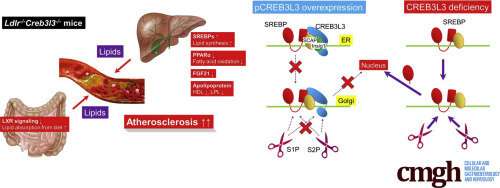Protecting against atherosclerosis at the molecular level


Atherosclerosis is the result of a buildup of lipids in the inner walls of blood vessels, and is a major cause of heart disease and stroke. In a new study, researchers from the University of Tsukuba discovered a novel role for cAMP responsive element-binding protein 3 like 3 (CREB3L3) in the development of atherosclerosis and identified a mechanism by which it exhibits protective effects against atherosclerosis.
Atherosclerosis is the detrimental result of long-time high blood lipid levels leading to a thickening of the inner walls of blood vessels through the formation of a so-called plaque. As a result, blood flow to the brain and heart may decrease over time, and once the plaque ruptures, platelets in the blood stream aggregate and clog the blood vessel as they try to repair the damage. While a number of proteins and mechanisms are known to play a part in the development of atherosclerosis, research is ongoing to fully understand this complex process. CREB3L3 is a transcription factor, which is a protein that binds to DNA and regulates gene expression in the liver and small intestine, and plays an important role in the hepatic triglyceride and glucose metabolism.
“Though we have known about atherosclerosis for a long time now, there is still much to learn about the molecular basis for it,” corresponding author of the study Professor Hitoshi Shimano says. “The goal of our study was to understand the role CREB3L3 plays in the development of atherosclerosis and whether it lends itself to a therapeutic target against atherosclerosis.”
To achieve their goal, the researchers looked into how the absence or the overexpression of CREB3L3 would affect the development of atherosclerosis. To investigate the absence of CREB3L3, the researchers generated knockout mice that were deficient in the protein in the liver or intestines, or both. To investigate the overexpression, the researchers generated a transgenic mouse overexpressing CREB3L3 in the liver. Because atherosclerosis does not naturally occur in mice, the researchers made use of a mouse line, in which the receptor of LDL cholesterol (LDLR), commonly known as “bad” cholesterol, is absent. Because LDL cholesterol circulating in the build cannot be taken up by cells, it builds up in blood vessel walls and leads to the formation of atherosclerosis. By crossing CREB3L3 mice with the LDLR mouse and feeding them with a western diet, the researchers had a system to study the role of CREB3L3 in the development of atherosclerosis.
Interestingly, the researchers found that absence of CREB3L3 in either the liver or intestines resulted in an exacerbation of high blood lipid levels and atherosclerosis formation, and more so in the mice, in which CREB3L3 was knocked out in both organs. Conversely, overexpressing the protein in the liver markedly suppressed blood cholesterol levels and atherosclerosis formation. By looking closer at the molecular mechanism by which CREB3L3 confers protective effects against atherosclerosis, the researchers found that it interacts with sterol regulatory element-binding protein (SREBP) to trap it in a cellular compartment called endoplasmic reticulum and prevent it from inducing the expression of genes important for the formation of atherosclerosis.
Source: Read Full Article